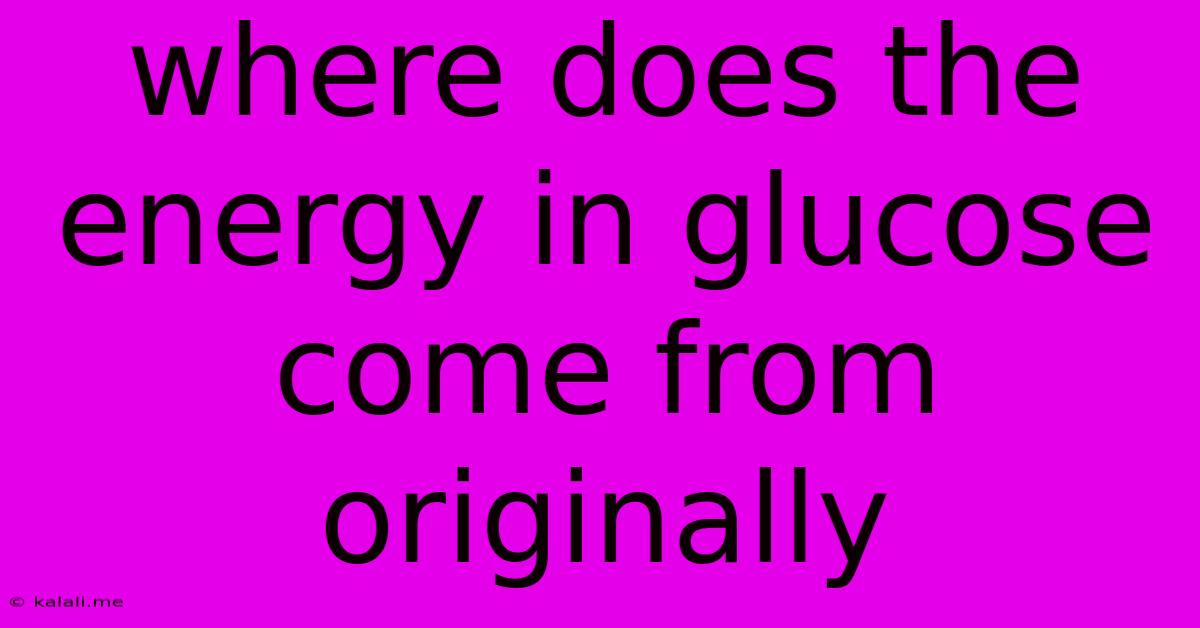Where Does The Energy In Glucose Come From Originally
Kalali
May 10, 2025 · 2 min read

Table of Contents
Where Does the Energy in Glucose Come From Originally?
The energy we harvest from glucose, the primary fuel for our cells, doesn't originate within the glucose molecule itself. Instead, it's a cleverly stored form of energy captured from the sun, a journey involving several fascinating biological processes. This article explores the ultimate source of glucose energy and the remarkable transformations it undergoes before powering our lives.
The Sun: The Prime Energy Source
The story begins with the sun, the ultimate source of almost all energy on Earth. Through photosynthesis, plants and other photosynthetic organisms harness the sun's radiant energy. This process converts light energy into chemical energy, specifically in the form of glucose. Think of it as nature's ingenious way of capturing solar power and storing it in a readily usable form.
Photosynthesis: Capturing Sunlight's Energy
Photosynthesis occurs within chloroplasts, specialized organelles found in plant cells. Here, chlorophyll, a green pigment, absorbs sunlight. This absorbed energy drives a complex series of reactions that ultimately convert carbon dioxide (CO2) from the atmosphere and water (H2O) into glucose (C6H12O6) and oxygen (O2). This process can be summarized by the following equation:
6CO2 + 6H2O + Light Energy → C6H12O6 + 6O2
The glucose produced during photosynthesis isn't just a simple sugar; it's a highly energized molecule. The energy stored within its chemical bonds is precisely the energy originally captured from sunlight.
Glucose: A Stored Form of Solar Energy
Plants use this newly created glucose for their own metabolic processes – growth, repair, and energy production. Animals, including humans, obtain glucose by consuming plants or other animals that have consumed plants. Through cellular respiration, we break down this glucose, releasing the stored solar energy in a controlled manner to fuel our own cellular activities.
Cellular Respiration: Releasing Stored Energy
Cellular respiration is the metabolic pathway that extracts energy from glucose. It's a multi-step process that occurs in the mitochondria, often referred to as the "powerhouses" of the cell. This intricate process involves several key steps, including glycolysis, the Krebs cycle (also known as the citric acid cycle), and oxidative phosphorylation. Ultimately, the energy stored in glucose's chemical bonds is converted into ATP (adenosine triphosphate), the cell's primary energy currency.
The Energy Transformation Summary:
To summarize, the energy in glucose originates from:
- The Sun: The initial source of energy is sunlight.
- Photosynthesis: Plants convert light energy into chemical energy stored in glucose.
- Glucose: This acts as a storage unit for solar energy.
- Cellular Respiration: Animals break down glucose, releasing the stored solar energy as ATP to power cellular functions.
Therefore, every time we utilize energy from the food we eat – whether it's from a plant or an animal – we're ultimately using energy that originally came from the sun, cleverly captured and stored through the remarkable processes of photosynthesis and then released through cellular respiration. This incredible energy transformation is fundamental to life on Earth.
Latest Posts
Latest Posts
-
How Long To Heat Water In Microwave
Jul 18, 2025
-
40 Oz Of Water Is How Many Cups
Jul 18, 2025
-
How Many Eighths In A Quarter Pound
Jul 18, 2025
-
Can The Sine Of An Angle Ever Equal 2
Jul 18, 2025
-
How Many Months Is A Hundred Days
Jul 18, 2025
Related Post
Thank you for visiting our website which covers about Where Does The Energy In Glucose Come From Originally . We hope the information provided has been useful to you. Feel free to contact us if you have any questions or need further assistance. See you next time and don't miss to bookmark.